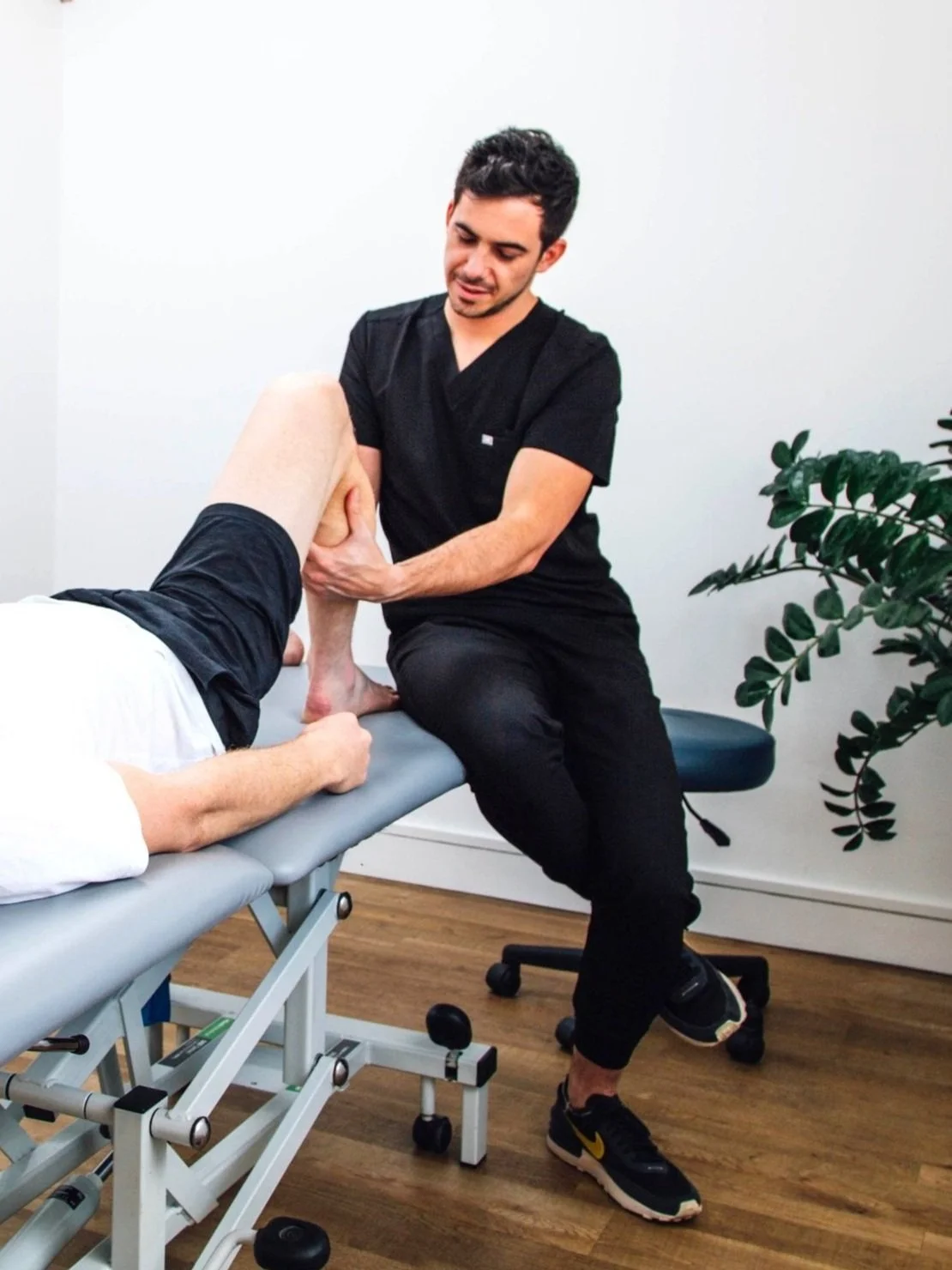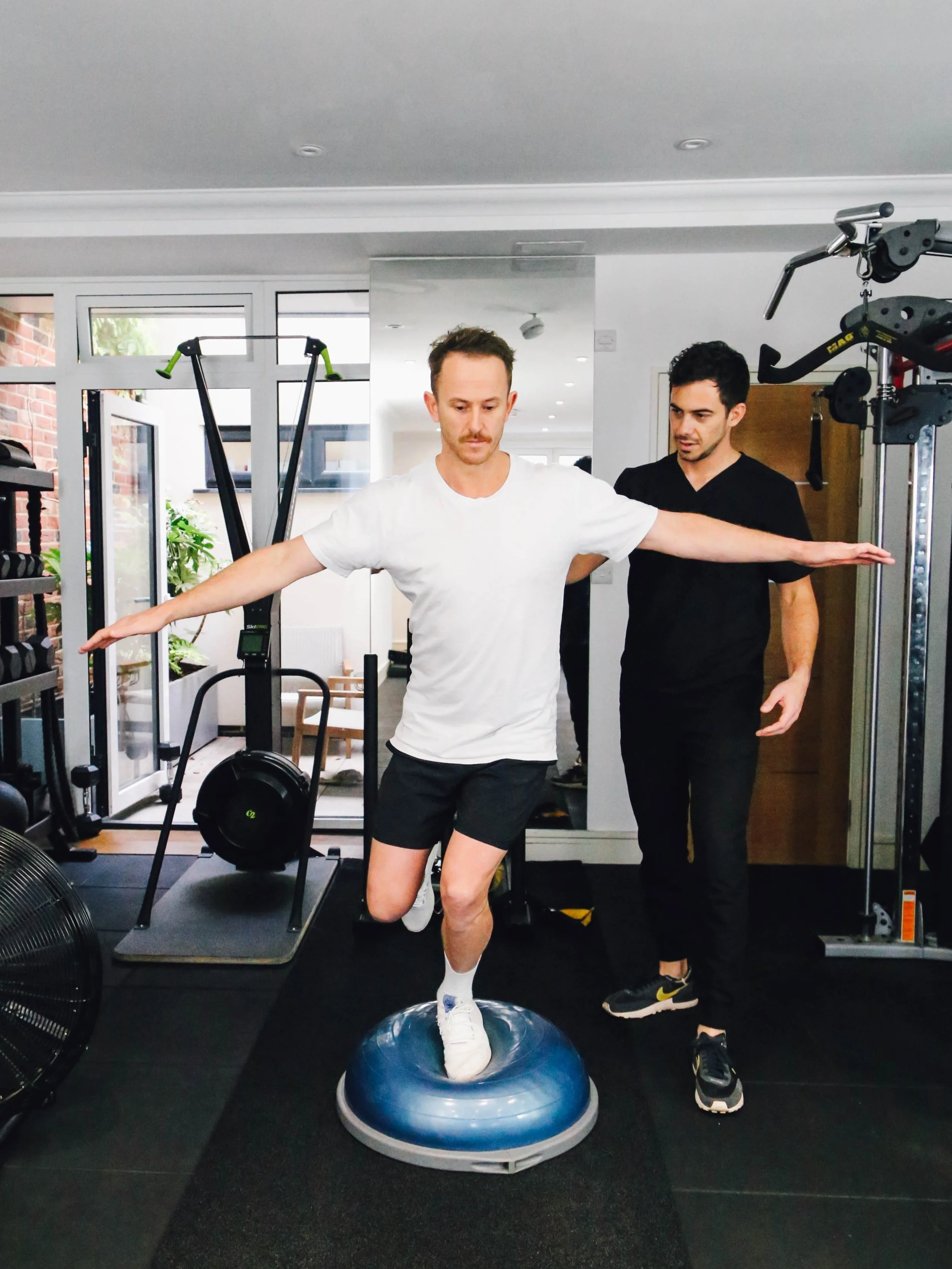
Sports Injury Clinic in North London
Over more than a decade of practice, we’ve developed a wide range of clinical interests. Here we are taking a deeper look at sports injuries, for other conditions see here.
Sports injuries are common occurrences that can occur during physical activities, ranging from mild strains and sprains to more severe fractures and tears. These injuries can affect various parts of the body, including muscles, tendons, ligaments, bones, and joints, and can result from factors such as overuse, improper technique, sudden impacts, or repetitive motions. Proper prevention, recognition, and management of sports injuries are essential to promote recovery, prevent complications, and optimise athletic performance.
Book Your Appointment at our London Clinic
Book your appointment today using the easy online booking system, or get in touch to speak with a member of the team about how we can help you.
Common Sports Injuries We Treat
Sprains occur when ligaments (tissues connecting bones to each other) are stretched or torn. They often happen in joints such as the ankle, knee, or wrist and can range from mild to severe, depending on the extent of damage.
Strains involve the stretching or tearing of muscles or tendons (tissues connecting muscles to bones). They commonly occur in the hamstrings, quadriceps, or groin muscles and can result from sudden movements or overuse.
Tendonitis is inflammation or irritation of a tendon, usually due to repetitive movements or overuse. It often affects tendons in the shoulders (link), elbows, knees (link), or ankles and can cause pain, swelling, and limited mobility.
Fractures are breaks or cracks in bones and can occur due to sudden impacts, falls, or overuse. Common types of fractures in sports include stress fractures (cracks from repetitive stress) and traumatic fractures (resulting from direct trauma).
ACL tears (anterior cruciate ligament tears) are common knee injuries, particularly in sports that involve sudden changes in direction (basketball, football, and skiing). They often require surgical intervention and extensive rehabilitation.
Rotator Cuff Injuries involve damage to the muscles and tendons surrounding the shoulder (link) joint. They can result from overuse, repetitive motions, or sudden impacts and may cause pain, weakness, and limited range of motion in the shoulder.
Runner's Knee (Patellofemoral Pain Syndrome) is a common knee injury characterised by pain around the kneecap (patella), often aggravated by activities such as running, squatting, or climbing stairs. It can result from factors such as overuse, muscle imbalances, or improper biomechanics.
Plantar Fasciitis is inflammation of the plantar fascia, a thick band of tissue that runs along the bottom of the foot. It often causes heel pain, especially with the first steps in the morning or after prolonged periods of rest, and is common in activities such as running or jumping.
These are just a few examples of the many types of sports injuries that athletes may encounter. Proper prevention strategies, appropriate training techniques, and prompt treatment are essential for managing sports injuries effectively and minimising their impact on athletic performance and overall well-being.
Causes of Sports Injuries
Overuse due to repetitive movements or excessive training without adequate rest. These injuries gradually develop over time and often affect tendons, muscles, and bones. Examples include stress fractures, tendonitis, and muscle strains.
Direct impact, collision, or sudden force applied to the body can result in traumatic sports injuries, ranging from minor bruises and cuts to more severe fractures, dislocations, or concussions. They commonly occur in contact sports like football, rugby, and hockey.
Incorrect form or technique during sports activities. Improper landing mechanics in jumping sports or incorrect weightlifting form can lead to strains, sprains, and other musculoskeletal injuries.
Muscle imbalances where certain muscle groups are stronger or weaker than others can predispose athletes to injuries. Imbalances in strength, flexibility, or stability can affect movement patterns and increase the risk of injuries.
Skipping warm-up exercises or neglecting to cool down after physical activity can increase the risk of sports injuries. Warm-up activities prepare the body for exercise by increasing blood flow to muscles and improving flexibility, while cool-down exercises help prevent muscle stiffness and promote recovery.
Rapid increases in training intensity, duration, or frequency without adequate progression can overload the body and increase the risk of injuries. Sudden spikes in activity levels, such as increasing mileage too quickly in running or adding weight too rapidly in strength training, can strain muscles, tendons, and joints.
Individuals with pre-existing medical conditions, such as previous injuries, musculoskeletal disorders, or chronic health conditions, may be more susceptible to sports injuries. These conditions can weaken tissues, alter biomechanics, or impair healing processes, increasing the risk of further injury during sports activities.
By understanding the various causes of sports injuries, we can implement appropriate prevention strategies, training techniques, and injury management protocols to minimise the risk of injuries and promote safe and effective participation in sports and physical activities.
Your Physiotherapy Team
Our physiotherapy service is delivered by a skilled and compassionate team: Kelly, Wilson, Rowan, Netta, and Tommaso. Each brings a unique background and special interests, but all share a commitment to providing supportive care focused on real-world outcomes. We work together, and with you, to ensure continuity of care and a collaborative treatment journey.
How We Help You Return to Sport After a Sports Injury
Managing the return to sports after a sports injury is a crucial aspect of rehabilitation and requires careful planning to ensure a safe and successful transition back to activity. Here's an overview of how our multidisciplinary team will help you.
Treatment and Rehabilitation Our team develops an individualised treatment and rehabilitation plan focused on addressing the specific needs of the athlete and facilitating optimal recovery. This physiotherapy treatment may include manual therapy and sports-specific rehabilitation exercises aimed at improving strength, flexibility, stability, and proprioception.
Gradual Progression We emphasise a gradual and progressive approach to returning to sports to minimise the risk of re-injury. Our rehabilitation programs are structured to gradually increase the intensity, duration, and complexity of activities as the athlete progresses through each stage of recovery.
Functional Testing Throughout the rehabilitation process, we utilise functional testing to assess the athlete's readiness to return to sports. Functional tests may include sport-specific movements, agility drills, and performance assessments to evaluate strength, flexibility, endurance, and neuromuscular control.
Education and Injury Prevention We provide education on injury prevention strategies, proper warm-up and cool-down techniques, sports-specific biomechanics, and techniques to reduce the risk of re-injury.
Collaboration with Coaches and Trainers We collaborate closely with coaches, trainers, and other members of the athlete's support team to ensure a coordinated approach to the return to sports process.
Monitoring and Follow-up We continue to monitor the progress closely during the return to sports process and provide ongoing support and guidance as needed. Regular follow-up appointments allow us to assess the patient’s response to training, address any concerns or setbacks, and make adjustments to the rehabilitation plan as necessary.
By taking a comprehensive and individualised approach to managing the return to sports, our multidisciplinary team helps our patients resume activity safely and effectively, regain confidence, and achieve their athletic goals.
Our London Sports Injury Clinic
Our conveniently situated London clinic features modern treatment rooms, a spacious waiting area and a well-equipped physio gym. Our treatments include physiotherapy, osteopathy, massage and private pilates.
Get in Touch
For any inquiries about the conditions we treat, the services provided, and bookings please use this form and our team will get back to you as soon as possible. We are here to help!
Book Your Appointment at our London Clinic
Book your appointment today using the easy online booking system, or get in touch to speak with a member of the team about how we can help you.





